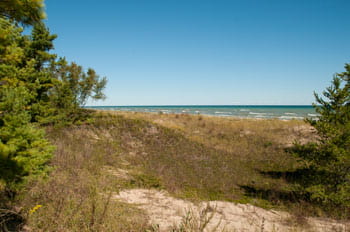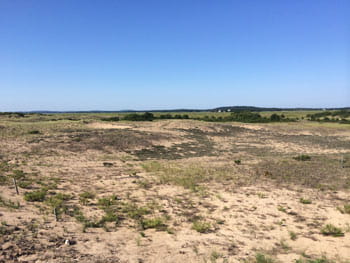Dr. Michael Draney (Natural and Applied Sciences) and James Steffen (Chicago Botanic Garden) recently published an article in the journal Great Lakes Entomologist titled “Disjunct Lake Michigan populations of two Atlantic Coast spiders, Disembolus bairdi and Grammonota pallipes (Araneae: Linyphiidae)”.
Steffen and Draney discovered two species of spiders living on the beaches of Lake Michigan that had only ever been found before living near the Atlantic Ocean. Scientists use the word “disjunct” to describe isolated populations like these that are related but widely separated from each other geographically. The discovery that the spiders also live along the shore of Lake Michigan, more than 800 miles inland raises some interesting questions, namely how did these very tiny (less than 2 mm animals) get to the Great Lakes across hundreds of miles of unsuitable habitat?
Populations can become separated from each other when the environment they live in separates into fragments due to geologic or climate events. Continents drift apart, rivers change their course or mountains rise, isolating populations on separate islands of suitable habitat. Populations also become disjunct from each other when species expand their ranges into new territories. This most often happens with species like birds or butterflies that can move long distances, or with species that hitch a ride on floating debris or on (or in) migrating animals.

Can you tell which of the photos is of a beach on Lake Michigan and which is a beach in New Hampshire?
(See the end of this post for the answer.)
While we don’t know how they got so far away from the Atlantic Ocean, the most probable explanation is that individual spiders ballooned inland by releasing long gossamer threads of silk that catch the wind and propel them along like a kite. Ballooning spiders are known to travel even thousands of miles using this technique. Those that were lucky enough to land near the shore of the Great Lakes found themselves in a hospitable and familiar habitat that they could colonize. The spiders do not care where that beach is located as long it provides what they need to survive and reproduce. Suitable habitat probably exists or existed in patches along the St. Lawrence Seaway and the Great Lakes east of Lake Michigan, and spiders may have “island hopped” by ballooning between such somewhat isolated islands of suitable habitat along the way from the Eastern Seaboard to northern Illinois.
Understanding more about disjunct populations like these helps us to understand how specialized species might fare as they become isolated. Under favorable conditions, isolated populations survive, and over time, due to mutation and natural selection, become so genetically different from their far away relatives that the population may evolve into a new species. When conditions are poor and habitats are degraded or lost to development, pollution, or climate change, small isolated populations are more likely to go extinct. By monitoring species like these we can better track the health of the Great Lakes.
Essentially all of the midwest’s plants and animals were absent from the Great Lakes thousands of years ago when the region was glaciated. Each species has a different history of where it took refuge during those ages, and how it got from there to here. The intersection of all these unique natural histories contributes to our complex and fascinating regional biodiversity. These Atlantic coast disjuncts are here because of the Great Lakes and the unique coastal habitats they make possible. The present study shows that not just plants (like dwarf lake iris or Pitcher’s thistle) but also animals can be dependent on special Great Lakes coastal habitats. You’ve probably never seen Disembolus bairdi and Grammonota pallipes. Still, these species are two additional (but tiny!) reasons to appreciate our Great Lakes.
The photo on the top was taken by Dr. Robert Howe at White Fish Dunes, WI and the photo on the bottom was taken by Dr. Steve Weeks of dunes in New Hampshire.

